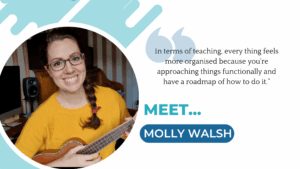Learning vocal anatomy (and all those long, hard-to-pronounce names) can be tricky for singers. Here are four tips to make it less daunting.
⏱ 3 Minute Read
Eimear McCarthy Luddy is a woman on a mission.
She wants singers to find vocal anatomy as magical and fascinating as she does.
The Irish vocal coach regularly shares her knowledge of the subject in #AnatoMonday posts on Instagram.
She’s also published a vocal anatomy colouring book featuring more than 80 pages of illustrations and – just what every singer needs – a cut-and-assemble larynx model.
Falling in love with vocal anatomy
On the Singing Teachers Talk podcast, Eimear explains that initially, she found vocal anatomy overwhelming.
“No matter how hard I tried to understand it, I just couldn’t,” she says.
“I’d pick up a super sciencey, super heavy textbook about anatomy and fall asleep reading it because it was really boring and inaccessible.”
But Eimear persisted. She signed up for various courses, but things only started to make sense when the person teaching her anatomy had a singing background.
“Singing teachers are so creative and fun, and they’re used to describing things from multiple viewpoints,” she says.
“They’re used to somebody not immediately clicking with an idea, so their response isn’t ‘But why don’t you understand it?’. Their response is, ‘Okay, let’s play and go at it a different way; how about this?’.
“Once I realised you can apply that method of teaching singing to something like anatomy, I realised that you can also make it more fun.”
Hacks to teaching and learning vocal anatomy
So how does Eimear bring the subject of vocal anatomy to life with her students? Here are some of her tips.
1 Meet students where they are
Some students are going to relish taking a deep dive into the workings of the vocal mechanism. Others may have no interest in going there at all.
For this reason, it’s essential to tailor your approach to each student’s needs and interests.
“If I have someone who wants to epically nerd out about anatomy, I will do that,” Eimear says.
“But if I have someone who doesn’t, I’ll get there a different way.
“At the end of the day, singing is a motor skill. We know the more that we play and sing and explore in a lesson, the better we’re going to learn, rather than if we just talk.”
2 Start Small
Whether you’re trying to teach yourself or others, start small.
“I remember someone saying to me that it does take a number of passes around the track before you can actually start holding on to the information,” she says.
“It only started making sense to me once I picked one thing [and focused on that]. For example, I spent one week just picking up anatomical terminology.”
3 Make silly connections
Eimear finds it helpful to make unusual or silly connections to aid learning.
“My brain is a bit neuro-spicy in the way that it works. I like to find unusual connections between things to keep life interesting,” she says.
“When I’m presented with something that is linear and goes from point A to point B and is black and white and stuffy, I find ways to make it colourful so that it’s easier to remember and understand.”
Whether it’s funny rhymes, silly songs or references to your favourite biscuits – if it will help you (or your student) to remember and understand, go for it.
“Make it relatable and fun. There’s always some kind of magic or joy or unusual way to see something that makes it better.”
4 Be Patient
Learning is not a race.
“Forgive yourself for not knowing everything straight away because it’s really hard to know all the answers,” Eimear says.
“Learn a few things at a time and just keep going.”
Learn more
Listen to the full interview with Eimear to learn how she created and published a colouring book.
Study
Want to learn all you need to know about how the voice works? Sign up to study with BAST Training. Both our Foundation and Level 5 courses cover vocal anatomy.
Main image: Canva




